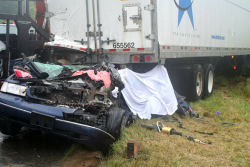
— The Stop Underrides Act of 2017 has been introduced by Senators Marco Rubio (R-FL) and Kirsten Gillibrand (D-NY) to prevent underride crashes that occur when a car slides under the body of a large truck or trailer.
An underride crash can easily kill car occupants even if the crash occurs at low speeds, but current federal laws mandate guards only on the rear of trailers and certain trucks.
However, those standards are considered outdated by underride guard proponents.
According to the Institute for Highway Safety, 427 people were killed in passenger vehicles that slammed into the backs of tractor-trailers, and that was in 2015 alone.
One family affected by a faulty underride guard has spent the past few years pushing for improved underride guards after a crash killed two teenage girls. AnnaLeah Karth, 17, and her sister Mary, 13, were killed when the Ford Crown Victoria they were riding in was involved in a crash on May 4, 2013 (pictured above).
According to the family, they were driving on I-20 in Georgia when the traffic slowed due to an earlier crash about two miles ahead. As the Crown Victoria slowed down, a truck hit the car, sending the car spinning backward into the tractor-trailer ahead of them.
Although the trailer was equipped with a rear underride guard, the guard failed and killed the two girls who were in the backseat of the car.
The Stop Underrides Act addresses rear, side and front underride guards that would be installed on "all trailers, semi-trailers, and single unit trucks with a gross vehicle weight rating of more than 10,000 pounds that are manufactured on or after the effective date of the rule."
Crash tests will be used to verify a guard meets standard if a vehicle traveling at 35 mph is prevented from moving underneath the rear of a trailer or single unit truck.
Rear Underride Guards
The guard must pass an impact test in which a vehicle hits the center of the rear of the trailer or truck, an impact in which 50 percent the width of the vehicle overlaps the rear of the trailer or truck. Another test will consist of an impact in which 30 percent of the width of the vehicle overlaps the rear of the trailer or truck.
Side Underride Guards
A side underride guard will have to be able to prevent intrusion from the body or frame of a vehicle into the passenger compartment of the car that hits the guard while traveling 35 mph at any angle between 10 and 90 degrees.
After a period of time, older trailers and trucks would need to be retrofitted with rear and side guards.
Trailers and trucks would also need to be equipped with front underride guards to prevent trucks from literally overriding passenger vehicles.
As seen in the fatal Karth crash, guards can fail in a crash, so the proposed legislation says periodic inspections must be conducted to ensure the guards can withstand impacts. For guards that fail inspection, a sticker will be applied to the vehicle or trailer indicating an "out of service" violation and owners could face fines.
Before the truck or trailer can be used, the guards must be repaired or replaced by the affected owners.
The National Transportation Safety Board recommends that new trailers be equipped with underride guards, but all the agency can do is make recommendations. It's up to Congress to create laws that follow those recommendations.
As can be imagined, the trucking industry hasn't been excited about equipping all affected trucks and trailers with guards due to the additional cost involved. In addition, the industry says it has concerns about what the addition of side and front guards may do to weaken the trailers by increasing their weight.
While the bill has been introduced, there is no guarantee it will become law as it still needs to make it through the Senate Commerce, Science and Transportation Committee. The Act will join the House version introduced by Representatives Steve Cohen (D-TN) and Mark DeSaulnier (D-CA).




